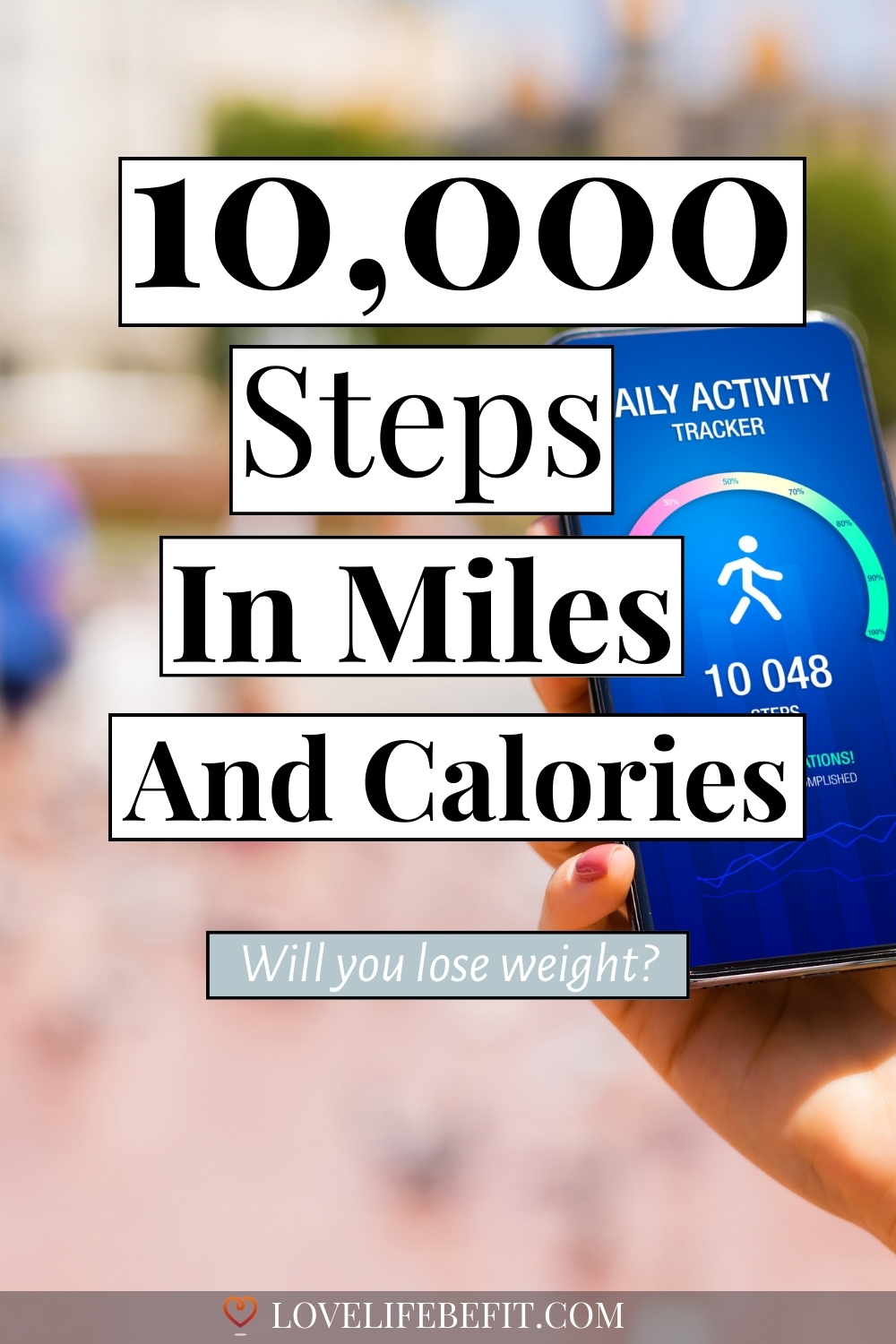How Many Miles In 10000 Steps (And How Many Calories Burned)
By far the easiest way to improve your fitness is to start walking and 10,000 steps a day is a great goal to aim for! But what happens when you walk 10000 steps? How many miles to walk 10,000 steps, and how many calories can you expect to burn?
This post includes tips to hit your 10000 steps daily goal and help to calculate your stride length. So if you want to know what happens when you walk 10,000 steps every day- read on!

How Many Miles Is 10000 Steps?
For the average person, a 10,000-step goal is approximately 4.5 to 5 miles. That’s 7.2 to 8.0 kilometers.
It’s less if you have a short stride and more for a long stride.
A typical step length is 26 to 30 inches (2.1 to 2.5 feet). A person with a step length of 2.1 feet will walk just under 4 miles for 10,000 steps. You can walk 4.7 miles for 10,000 steps with a step length of 2.5 feet.
Related post: Walking 5 Miles A Day: Benefits And What Happens To Your Body?

How to Calculate 10000 Steps in Miles
The number of steps in a mile depends on your stride length and varies from person to person – there’s no one-size-fits-all answer. These are some of the factors affecting the distance you walk:
- Height – if you’re taller you’ll probably have a longer stride length.
- Gender – your sex will make a difference. Men and women have different biomechanics and this affects your gait. Men tend to take longer strides.
- Speed – when you walk faster your stride length is longer.
- Fitness – being fitter will affect your walking gait.
The accurate way to calculate how many miles is 10,000 steps comes from your average stride length. But you can also estimate the distance based on your height, gender, and walking speed. Your pedometer or fitness tracker uses this method to estimate distance.

Estimated Number Of Miles Walked In 10,000 Steps For The Average Person
Research suggests speed, gender, and height make a big difference in walking distance for the same number of steps. Find out more in this related post: How Many Steps In A Mile Walking Or Running?
Based on this research I’ve produced the tables below. Use them to find your walking distance for 10,000 steps based on your height, sex, and walking pace.
Number Of Miles In 10,000 Steps For A Woman Based On Height And Speed
| Height | Slow Walk 3.0 mph | Brisk Walk 3.5 mph | Fast Walk 4.0 mph |
| 5 foot | 4.21 | 4.59 | 4.87 |
| 5 ft 1 inch | 4.24 | 4.62 | 4.90 |
| 5 feet 2 inches | 4.27 | 4.65 | 4.94 |
| 5 feet 3 inches | 4.29 | 4.68 | 4.97 |
| 5 feet 4 inches | 4.32 | 4.71 | 5.01 |
| 5 feet 5 inches | 4.35 | 4.74 | 5.04 |
| 5 feet 6 inches | 4.37 | 4.77 | 5.08 |
| 5 feet 7 inches | 4.40 | 4.80 | 5.11 |
| 5 feet 8 inches | 4.43 | 4.84 | 5.15 |
| 5 feet 9 inches | 4.46 | 4.87 | 5.19 |
| 5 feet 10 inches | 4.48 | 4.90 | 5.23 |
| 5 feet 11 inches | 4.51 | 4.94 | 5.27 |
| 6 foot | 4.54 | 4.99 | 5.31 |
Number Of Miles In 10,000 Steps For A Man Based On Height And Speed
| Height | Slow Walk 3.0 mph | Brisk Walk 3.5 mph | Fast Walk 4.0 mph |
| 5 feet 4 inches | 4.38 | 4.78 | 5.09 |
| 5 feet 5 inches | 4.41 | 4.81 | 5.13 |
| 5 feet 6 inches | 4.44 | 4.85 | 5.16 |
| 5 feet 7 inches | 4.47 | 4.88 | 5.20 |
| 5 feet 8 inches | 4.49 | 4.91 | 5.24 |
| 5 feet 9 inches | 4.52 | 4.95 | 5.28 |
| 5 feet 10 inches | 4.55 | 4.98 | 5.32 |
| 5 feet 11 inches | 4.58 | 5.02 | 5.36 |
| 6 foot | 4.61 | 5.05 | 5.40 |
| 6 foot 1 inch | 4.64 | 5.09 | 5.44 |
| 6 foot 2 inches | 4.67 | 5.13 | 5.48 |
| 6 foot 3 inches | 4.70 | 5.16 | 5.53 |
| 6 foot 4 inches | 4.73 | 5.20 | 5.57 |
Stride Length vs Step Length
I always find this a bit confusing. Are stride length and step length the same thing? It doesn’t help that most people mix these up!
Stride length is the distance between two successive steps, one with each foot. Step length is the distance only one foot travels. This means your stride length is twice your step length.
But just to make things more confusing, pedometers such as your fitness band, will use the term “stride length” when it’s step length that’s measured.

Finding Your Average Stride Length
Stride lengths vary for different people. The easiest way to get an accurate value for your average stride length is to measure it.
- Make two markers as far apart as possible in your living room or backyard. Anywhere you have space.
- To get an accurate result, the distance between the markers needs to be at least 20 steps.
- Measure the distance between the two markers and walk between the two points, at your normal speed, counting your steps.
- Divide the distance between the number of steps to get your average step length.
Your step length is the distance between the point of initial contact of one foot and the point of initial contact of the opposite foot. Reference University of Oklahoma Health Sciences Center
Your stride length will be twice your step length BUT if you’re calibrating your fitness tracker, add your step length instead of your actual stride length.
It’s a good idea to find your stride length for different speeds, such as a slow, medium, and fast pace.
Use your average step length in this table to find the distance walked.
| Step Length (ft) | Step Length (m) | 10,000 Steps In Miles |
| 2.0 | 0.61 | 3.78 |
| 2.05 | 0.62 | 3.88 |
| 2.1 | 0.64 | 3.98 |
| 2.15 | 0.66 | 4.07 |
| 2.2 | 0.67 | 4.17 |
| 2.25 | 0.69 | 4.26 |
| 2.3 | 0.70 | 4.35 |
| 2.35 | 0.72 | 4.45 |
| 2.4 | 0.73 | 4.55 |
| 2.45 | 0.75 | 4.64 |
| 2.5 | 0.76 | 4.73 |
| 2.55 | 0.78 | 4.83 |
| 2.6 | 0.79 | 4.92 |
| 2.65 | 0.81 | 5.02 |
| 2.7 | 0.82 | 5.11 |
How Long Does It Take To Walk 10,000 Steps?
It takes between 70 to 80 minutes to walk 10,000 daily steps at a brisk walking pace of 3.5 miles/hour.
For a slower pace of 3.0 miles per hour, allow 90 to 100 minutes. Find out more about how long it takes to walk 10000 steps.

10,000 Steps Calories Burned
That’s a difficult question to answer, as the amount of calories burned depends on fitness level, weight, walking efficiency, and speed – the rate of burning calories will shoot up if you’re walking uphill!
It’s typical to burn around 80 calories per mile walking at a brisk pace – that’s 320 to 376 for 10,000 steps.
You can get a much better answer by entering your weight, walking speed, and walk duration in my calories burned walking calculator.
Health Benefits Of Walking 10,000 Steps Every Day
Increasing your physical activity levels and the amount you walk every day comes with so many benefits.
Here are just a few:
Improved heart health
The American Heart Association recommends 150 minutes of moderate exercise a week. A daily step count of just 3000 steps will hit this target but extra steps are a great way to improve your overall health. Keep your walking brisk so you’re boosting your heart rate!
Weight loss and weight management
Combined with eating a healthy diet and a small calorie deficit, a daily walk can be the best way to lose weight. Hit your fitness goals and keep your weight off for good!
Reduce blood sugar levels and lower blood pressure
That’s good news for reducing the risk of chronic diseases, such as heart disease, diabetes, or stroke.
Increased energy levels
Avoid the afternoon productivity slump by going for a quick lunchtime walk.
Lower stress levels and improved mental health
Walking is a great way to destress at the end of a busy day and can even help you sleep better at night.
These are just a few of the benefits of exercise and having an active lifestyle. The amount of time spent walking is an investment in your future health!

Tips For Reaching Your Daily Step Goal
Daily step counts can be great motivators but it’s not always easy to hit your step count target every day. Here are a few tips to get more steps in a day:
- Take the stairs instead of the elevator or escalator – go up and down them several times if possible!
- Go for a 15-minute walk during your lunch break – it’s perfect for a reset.
- If you have to drive somewhere, park further away from your destination and walk the last mile or two.
- Take regular breaks from sitting if you work at a desk – stand up and walk around for a few minutes every hour.
- Walk to the shops instead of using the car.
- Split your target distance into two or three short walks to make it more manageable.
These are just some of the different ways you can fit walking into your daily routine. To get the most benefit out of walking, make sure some of your steps are purely for exercise where you’re walking at a faster pace.

A Word From Love Life Be Fit
The best advice is to find a distance you can walk daily and adopt as a regular habit. An achievable step goal. For some people, it’s better to take shorter, more intense walking breaks where you walk at a faster pace and burn more calories per mile. Other people will go all out and walk 20000 steps a day!
The aim is to make exercise part of your daily routine and if that’s just 20 minutes of fast-paced walking, it’s a start.
Exercising regularly is hugely beneficial for controlling your weight and staying healthy. If you’re really overweight or haven’t exercised in years, walking is a terrific way to start improving your fitness.








